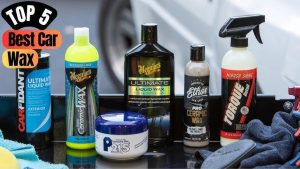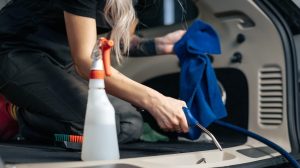Car detailing requires special tools, and having access to them makes the task simpler and faster. From jack stands and jack stands with reliable hydraulic lift mechanisms to spray bottle racks – having these handy items at your fingertips makes this job so much simpler and faster.
Waxing by hand has long been an accepted practice, but using a buffer can save time and effort while producing better results. Just make sure it contains pads designed specifically for polishing or waxing to achieve best results.
1. Bug and Tar Remover
Bug and Tar Remover is one of the essential car waxing tools every detailer should own, used to quickly and effectively dissolve bugs, baked-on tar spots, stubborn stains and tree saps without damaging the paint or clear coat.
Spray-on product are perfect for use during car washing on sunny days prior to rinsing off any suds with your hose-attached brush, helping ensure that surfaces of the vehicle are ready for waxing without adhering to unwanted surfaces such as moldings and plastic body parts. Using them this way ensures a great surface to apply wax to and will protect the paintwork against adhering of wax to unintended spots such as moldings.
As with any product, to achieve optimal results it’s essential that you follow all recommended instructions and amounts when using this one. Also be sure to apply it on a shaded surface and controlled environment so as not to apply the product in areas not intended, such as rubberized bumper protectors or PPF (Paint Protection Film). PPF (Paint Protection Film) coatings protect car finishes by only being applied at the front.
2. Microfiber Cloths
Microfiber cloths are essential tools when it comes to detailing your car. Their highly absorbent qualities help remove wax without leaving behind scratches or streaks on the paint, so these cloths should never leave behind scratches or streaks on its way off your vehicle. You can purchase microfiber cloths at most auto supply stores online as well as local car shops and detailing centers.
Before applying any type of car wax, it’s crucial to polish the paint and remove any dirt or debris trapped beneath. A dual-action polisher can help do just that as they operate at lower speeds than buffers and are safer to use, giving your car a clean and shiny finish that will stand the test of time.
Once your vehicle is polished and cleaned with a towel, wax can be applied in thin layers across its entirety. When this step has dried completely, a buffing pad should be used to ensure an even and consistent coat of wax is created.
3. Soft Brush
If you’re going to invest in professional car wax application, investing in a soft brush is worth every cent spent. Available at most auto parts stores for only a few dollars, these brushes allow for greater reach into those hard to reach spots than your fingers can reach alone.
Wax can be difficult to remove if left on for too long, so it is best to wax in cool, dry conditions. Working in a garage or covered area is also recommended as sun baking the wax onto your paint can create an unwanted mess that you will need to clean up later. Each type of wax you select will likely come with specific application directions; we advise following those closely to get the most from your DIY effort – only applying thin layers across all of your painted surface with an applicator pad for best results.
4. Wax Applicator
Wax applicators are an indispensable part of ensuring even coverage and achieving flawless results when applying liquid or paste car wax. Your choice of applicator makes all the difference in how your results turn out.
Foam wax applicators are great tools for applying even, smooth coats of car wax to the exterior of your vehicle. Crafted from high-grade closed cell soft poly-foam material, these tools can easily be washed after each use to keep them looking their best.
Start by carefully reading through your chosen car wax box’s instructions, selecting a shaded area to work in and beginning to apply the product a small section at a time (about two to four square feet at once), so as to prevent getting any product on headlights or tail lights.
Once the wax has set up, allow it to fully harden before buffing away any streaks with a microfiber towel. If there are any remaining, another coat of wax can be applied, though you must wait for its previous layer to fully cure before proceeding with buffing it off.
5. Detailing Brushes
Wax is an essential finishing treatment to keep your vehicle’s paint job protected against oxidation, UV sun damage and give your car showroom-quality shine. But for proper application of wax you will require certain tools and techniques.
Chemical Guys provides this all-in-one kit designed to kick-start any DIY detailing project with this comprehensive collection of tools and towels, 16-ounce bottles of waxes and cleaners, as well as their dual-action polisher to remove paint contaminants and prepare your vehicle for an immaculate coat of wax.
Use of the clay bar with detailer spray or Simple Green as a lubricant will allow it to glide across your vehicle’s paint surface, trapping and lifting contaminants without scratching. A thorough rinse with water afterwards will leave behind a smooth and clean paint surface, ready for further detailing steps.



